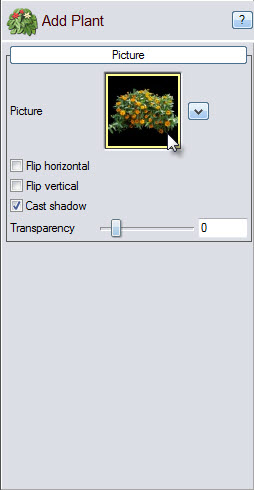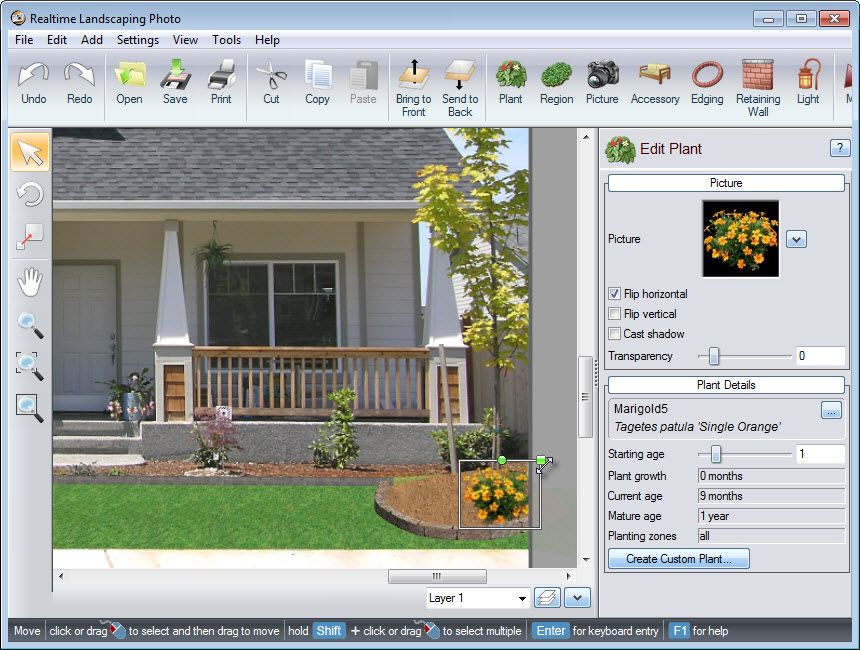This guide will show you how to design a landscape over a photo using Realtime Landscaping Photo.
The first step is to take a picture of the area you want to landscape using a digital camera or cellphone. We recommend doing this when the sun is behind you and to keep the camera as level as possible.

The next step is to upload the photo to your computer using directions provided with your cellphone or digital camera.
When you first start Realtime Landscaping Photo, the following welcome menu will appear:

To get started, click Start a New Design using the Wizard. A dialog box will appear:

Click Next to continue, and then select the type of picture you would like to import. Select Background Photo and then click Next.

Select the photo you wish to import, and then click Open. If you are happy with the selected image, click Next, or click Select Picture if you would like to choose another image.

Next, you will be prompted to input a file name for your imported picture. Click Set File Name, type in the desired file name, and then click Next.

By default, the wizard will make a copy of your picture. If you happen to make changes to the original image, you can always reimport it using this wizard. Click Finish, to complete the wizard and import your picture.

The background will become the picture you just imported and is now ready to be landscaped.
The image below shows the interface of Realtime Landscaping Photo with each section labeled:

To zoom in and out, rotate the Middle mouse wheel and hold it down to pan the view. Additionally, you can use the Zoom and Pan tools located on the toolbar on the left-hand side of your screen.
To add grass to your design, click the Region button. Left click to place points and create the outline of your region, then Right click to place the last point.

Select the following material image in the Object Properties panel, to take you to a variety of different materials:

A dialog box will appear with a selection of different region fill materials. Select the Grass category, make your selection from the different options offered, and then click OK.

If you wish to further edit the appearance of the material, you can use the options found in the Object Properties panel.
To add a flower bed to your design, click the Region button again and create the outline. Left click to place points, and Right click to place the last point. Select the following material image to choose the material of your flower bed:

When the dialog box appears, select the Ground category, make your selection from the variety of options, and then click OK.

To further edit the appearance of the material, you can use the options found in the Object Properties panel.
If you wish to add edging to your flowerbed, click the Edging button. Left click to place points, then Right click to place the last point.

Next, we will make adjustments to the edging so that it follows the curve of your flowerbed. To select all the points in your edging, Left click and drag to highlight the points. You will notice that your selected points will appear red in color, while unselected points will appear yellow. You are also able to select multiple points by holding down the Shift key on the keyboard while Left clicking the points you wish to edit. Click Edit Points and select Spline to match the curve to your flowerbed.

Click the material image seen below, if you would like to change the material of your edging.

A dialog box will appear and you will then be able to choose from a variety of different edging materials, including some from National brands Belgard, R.I. Lampus, Eldorado Stone, and Unilock. Make your desired selection and click OK.

To further customize the appearance of the edging, you can use the options found in the Object Properties panel.
To add a plant to your landscape design, click the Plant button.

Next, click the plant image seen below and it will take you to a large selection of plants.

A dialog box will appear with a variety of plants. To easily find a specific plant, utilize the Search option. You are able to make searches by common or botanical name, as well as by type and planting zone. Type in the name of the plant and click Search. Make your desired selection, and then click OK.

Left click to place your plant in the design. If you would like to adjust the plant size, Left click and hold the green box found at the corner of your selection. To rotate the plant, do the same with the green circle instead.

Here is what the landscape design looks like after more plants have been added:

To add 3D objects to your design, such as furniture, fencing or cars, click the Accessory button.

A dialog box will appear and you can choose from a large selection of different accessories. Make your desired selection and click OK.

Left click to place the accessory, then you can adjust the accessories’ size and rotation as desired. The following options can be adjusted to help it match the perspective of your photo:

By default, objects are drawn in the order that you added them. This drawing order is easy to change. For example, if you would like this plant to appear in front of the planter, Left click to select the plant and click the Bring to Front button. Additionally, you are also able to change the drawing order in small increments by pressing the F and B keys on the keyboard repeatedly.

Once you have completed your landscape design, you can either print it or export it as a JPEG or PDF file. Anything that extends into the gray area outside your background image will not be printed. Here is the completed landscape design.

Thank you for reading this guide, and please feel free to contact us for more information about our landscaping software.